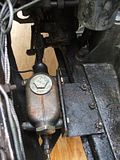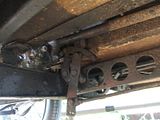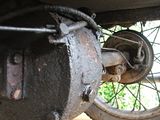
Welcome to the Austin Seven Friends web site and forum
As announced earlier, this forum with it's respective web address will go offline within the next days!
Please follow the link to our new forum
http://www.austinsevenfriends.co.uk/forum
and make sure, you readjust your link button to the new address!
I am going to instal shortly an hydraulic braking system to my 1934 Ruby and I have a Morris Minor brake master cylinder to fit, but I have not yet determined its location - either fore or aft of the pedal.
Obviously, a mounting bracket will be required and this will be fabricated to suit the final location.
My question to the Forum is has anybody fitted a hydraulic master cylinder that has advice on the best location?
I would be grateful to read any thoughts anyone may have on their own experience.
Regards
Gary
Hi Gary,
I will take a phograph of the set up on my 29 Saloon and post it onto the site in the next few days. Hope this will be of help to you.
When I recently rebuilt the hydraulic system, which has been on the car sine the 1950's, I changed to silicon brake fluid which is very expensive (£30 a litre), but is supposed to stop the system from seizing up. I also use Girling brake springs instead of the Standard Morris Minor ones, they are much stronger.
Would you like photos of any other part of the system? Let me know and I will see what I can do.
Cheers
Ruairidh
Hi Gary,
There's quite a bit of information and photos on hydraulic conversions on the Speedex website including a photo of the master cylinder mounting. The push rod hole should be drilled 1 1/4" up from the brake pedal pivot. Make sure the cylinder is very secure otherwise the pedal will feel spongey due to flexure.
Good luck with the conversion, I would also recommend silicone brake fluid, it preserves all the cylinders etc.
Dave
What are peoples general thoughts on converting to hydraulic ?
All those that I have spoken to that have done it, have said they thought it made the brakes too vicious and had problems with wheels locking up etc.
I still run my special on cable brakes, and as long as they are adjusted and maintained properly, they are "adequate" for the job if you drive sensibly.
Phil
Thanks for the replies & Ruairidh - a photo would be helpful of the master cylinder thank you very much, I don't think I need anything else at the moment! I will look at the Speedex site also.
With regard to Phil's comment regarding the installation of hydraulic brakes, before I contemplated this conversion I spoke at length with a Chartered Mechanical Engineer and basically his comments were that the braking forces being applied to the chassis were overall likey to have no differences BUT the effectiveness of the braking system is very apparent - i.e. the effort required by the driver is consderably less using fluid than cable operation. It is a case for the driver to moderate his driving style if the brakes are found to be too vicious. Difficult for me to comment on this as I have never actually driven with cable brakes other than to move around on the drive!
Maximum braking effort is obtained in the split second just prior to the brakes locking up - the braking area (shoes in contact with the drum) is going to be roughly the same no matter which system is in use, but because the hydraulic system is more effective the locking up will require less driver effort to achieve.
The other advantages are of course that the system requires less maintenance & adjustment and performanance is consistent and that turning a corner does not affect the braking!
With modern day traffic conditions I would much pefer to have the ability to apply maximum braking effort in the knowledge that the brakes can be released on lock-up & then instantly re-applied to stop the vehicle, particularly in an emergency stop situation.
I will let you know how I get on with the works.
Gary
Having run a hydraulic braked seven for 40 odd years the only time I locked up was driving on ice in the 60s. Of our 3 RN saloons 2 have hydraulic brakes and one cable and Sue prefers the cable braked car. With the availability of decent brake linings in the 70s there is not a lot to chose between the two systems so much so I have acquired the necesary parts and converted one hydraulic braked car back to cable brakes. The earlier hard brake linings were as much use as a chocolate fireguard which is presumeably what led to hydraulic and Bowden conversions.
I soon learnt that the standard (hygroscopic) brake fluid causes rear brake cylinder seizures and have used the more expensive silicon brake fluid to cure this problem. Dave
Having just returned from holiday I shall, work permitting, continue rebuilding the 1934 Arrow replica chassis. I am now rebuilding the hydraulic brakes. I would be happy to send photographs of the brackets, pipe runs, brake shoes and back plates etc. The 'original' system had a master cylinder fitted in front of the brake pedal, although not a Morris Minor one. If you are anywhere near Lichfield, staffs, you would be welcome to come and look at work as it progresses.
Best wishes,
Hugh 
I agree with Phil a n original cable brake set up properly maintained is perfectly adequate for an Austin Seven.They are also nicer to drive with.My TT car capable of 85+ feels perfectly safe on a well adjusted set of cables.
My vote is for cable. As David says, properly set up and maintained cable brakes are perfectly adequate. The most important safety device occupies the space between your ears! My Chummy uses 6" cable brakes and they really are pathetic, but I seem to manage OK - being very aware of their limitations helps a lot. I know of two other people who are rebuilding their Specials to re-fit cable brakes.
Does anyone know of a suitable brake lining specification? When I get the Chummy's brakes relined I would like to be able to know what the relining company is talking about.
David
Isn't fitting hydraulic brakes like wearing a seatbelt or a crash helmet - it gives you a sense of security and encourages you to brake later and take more risks, generally driving your car as though it was a modern supermini. All very well driving it like a modern car until you have a modern crash and end up sitting in an (admittedly well-braked!) Molotov cocktail...
Thanks Hugh, it is really the position of the master cylinder that I was keen to hear about - too far away from you here on the coast in East Sussex - but thanks for the offer, much appreaciated.
The later comments are moving away from my original thread for any advice on installation of a hydraulic master cylinder!
But no matter - my feelings are that to cope with modern traffic conditions good brakes are essential, whether these be cable or hydraulic operation.
By changing the operation to something more efficient is making better use of brakes, meaning that when required to stop (& remember modern car drivers will not necessarily appreciate the stopping distances of an older vehicle, so do pull out, cross in front, etc., with due regard...) safely and without distress to driver & passengers.
I have read several contemporary road test reports on the various models and the brakes have been critised all that time ago! Austins themselves must have felt the brakes were not adequate by introducing improvements with the semi-girling system.
I intend to use my Ruby regularly (and where I live - Brighton - the traffic is quite congested) so confidence in a reliable and consistent braking system is important to me and hopefully better brakes will mean that trouble can be avoided.
Our cars are our personal property and modifications are a matter of personal taste and the really important thing in my view is to use the cars as much as possible to maintain their public profile.
Thanks for all for taking the trouble to reply.
Gary

Gary I posted this into the wrong thread earlier...
I do not advocate one type of braking system over another.
All the sevens I have on the road at present have different braking systems, I drive them all accordingly and, in my opinion, the best and most effective way to stop your car safely is to know it and assume nothing! The systems and my own thoughts on these are as follows:
Mk 1 Pearl Cabriolet: This has a coupled Austin system with off-set brake shoes. It is very effective, gives a smooth action on the pedal and once balanced correctly only requires the odd turn on the wing nut adjuster to maintain effective braking. I tow the mini caravan with this, which is not braked, and the system copes well.
’28 Chummy: This car has the original uncoupled system running on narrow brake shoes. The brakes work well and being uncoupled are easier to balance. I also find it comforting to know that if just using the foot pedal is not sufficient then I can add 100% more braking by using the handbrake. If you are descending long hills, such as we did in Norway this summer, you can alternate between handbrake and footbrake keeping both relatively cool and efficient.
’29 Saloon: This car was converted to a hydraulic system in the late 1950’s and is largely based on a Morris Minor system. The car brakes in a perfectly straight line, the pedal is quite hard and efficiency is good. I do find, however, that a lot of adjusting is required to keep the system working properly, this, I feel, is largely due to the relatively short movement the brake pedal makes compared to the Morris it came from. Having noted how well the system works I do not think that I would go to the bother to convert any cars that have cable systems, if you loose your hydraulic brakes you are stuffed, a broken cable will at least still allow two or three brakes to continue working in an emergency.
’30 Ulster Replica: This car uses an Austin coupled brake system with Girling back plates, mechanisms, shoes and drums on all four brakes. The car has a soft pedal that works very well indeed. Again, once this has been set up and balanced correctly the system is very efficient and only requires the odd turn of the butterfly nut. There is some work involved converting the back axle to take Girling back-plates, but the fronts can be fitted easily to an early sports beam.
My father’s ’29 Chummy has standard uncoupled system but he has fitted a Girling axle, stubs, mechanism, shoes and drums to the front. This works very well if you need to stop quickly.
I have a 6” braked car but have never driven it on the “road”, once it is roadworthy test drives around fields tell me that driving this will require longer stopping distances and the usual awareness of what is going on around you.
Take the time to really know your car, it’s braking (and other) idiosyncrasies and drive it accordingly.
Good luck
Ruairidh
p.s. I will post photos of the hydraulic master cylinder position later this week.
Gary,
hopefully this will assist you with your original request...


Also some photos of the handbrake adaptation and the fixing position of the cables on the back axle.
I make no apologies for oil and rust on my car, it is used and I like it like that!


Good luck with your conversion,
Cheers
Ruairidh
The mounting of the master cylinder in Ruairidh's saloon is the same as my RN and a friends RP saloon. It is best done with the engine out so you can get your head in to check the alignment of the cylinder to the pedal.
As with the cable brakes getting the correct brake linings is essential, when I rebuilt my first RN (which already had hydraulic brakes) I rebuilt the brakes with new shoes (relined by a friend in the trade), new hoses and new cylinders and when I braked I didn't know which way it was going to go. I finally changed the brake shoes for a spare set from the Morris minor centre because I thought there was some oil on one of the linings and from then on it stopped in a straight line. The linings my friend had fitted were too hard. The current asbestos free linings from the Morris Minor centre are no where near as good as the asbestos ones. Dave
Regards the comments on hydraulic brakes grabbing or being too vicious, this probably depends alot where you connect the master cylinder to the pedal and also the diameter of the master cylinder piston. My Dad had hydraulic brakes on his Opal in the 60s and was constantly twisting the radius arms.
Looking round the paddock at Prescott hill climb a few weeks ago i was interested to note that of the cars with hydraulic brakes some had the front brakes as installed on the morris with a twin leading shoe arrangement, some had a twin trailing (swap the back plates left to right) and some used rear brakes with the hand brake mechanism removed (leading and trailing). The added advantage of using the rear brakes on the front is that you have one aluminium slave cylinder instead of two iron ones.
Gary, good luck with your installation, anything that gives you confidence to use your car is a good thing. If the front brakes are too much, have a play with swapping a few things round, it wont be that hard to remedy!
Regards
Rob 
Thanks Ruairidh for the photos - that is very helpful, I can now get made a suitable mounting bracket!
Thanks to everyone for all the other comments.
Gary
